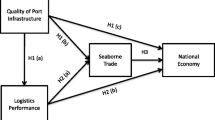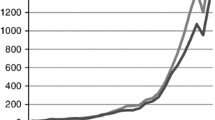Abstract
This paper examines the impact of seaborne trade on economic growth, from a port throughput and seaport efficiency perspective. We study the impact of port throughput on economic growth and the role seaport efficiency plays in that relationship. The paper uses panel data on 28 African countries with seaports, over the period 2010 to 2018, and we employ the system generalized method of moments approach for the analysis. We establish a direct significant positive effect of seaport efficiency and port throughput on economic growth in Africa. Specifically, a 1% increase in seaport efficiency (port throughput) improves economic growth between 0.014 and 0.038% (0.028% and 0.043%). We further show that improvement in seaport efficiency is vital for port throughput, to have its greater effect on economic growth in the Continent. Finally, regarding the other explanatory variables that influence economic growth, our findings reveal that, government spending, inflation, domestic investment, trade, financial development, and institutional quality are important determinants of economic growth in Africa. Based on these findings, we recommend port policies that promote seaport efficiency in Africa.
Similar content being viewed by others
Notes
According to the World Economic Situation Prospect [WESP] (2020) report, Africa remains a continent that faces enormous difficulties in achieving sustained growth, relevant to enhancing living standards of the populace.
Following Chen and Woo (2010) institutional quality index is computed by the formula.
\(\frac{{\sum }_{i=1}^{p}{\beta }_{i}{PC}_{I}}{{\sum }_{I=1}^{P}{\beta }_{I}}\) where \({\beta }_{i}(i=1,\dots ,p)\) denotes the \(ith\) eigenvalue and \({PC}_{i}\) the \(ith\) principal component selected based on the Kaiser Criterion.
References
Abdourahamane, A. S. 2015. Port Efficiency Underlies African Competitiveness. Retrieved October 5, 2019 from www.porttechnology.org/news/port_efficiency_underlies_african_competitiveness
African Development Bank’s first Transport Forum [AfDB]. 2015. Port Efficiency Underlies African Competitiveness. Retrieved October 5, 2019 from www.porttechnology.org/news/port_efficiency_underlies_african_competitiveness
Africa’s integral maritime strategy [AMS]. 2012. African Union. Africa’s integral maritime strategy.
Anderson, J.E., and D. Marcouiller. 2002. Insecurity and the pattern of trade: An empirical investigation. Review of Economics and Statistics 84 (2): 342–352.
Arellano, M., and S. Bond. 1991. Some tests of specification for panel data: Monte Carlo evidence and an application to employment equations. The Review of Economic Studies 58 (2): 277–297.
Ayesu, E.K., D. Sakyi, E. Arthur, and A.K. Osei-Fosu. 2022a. The impact of trade on African welfare: Does seaport efficiency channel matter? Research in Globalization 1: 100098.
Ayesu, E.K., D. Sakyi, and S.T. Baidoo. 2022b. The effects of seaport efficiency on trade performance in Africa. Maritime Policy & Management 1: 1–22.
Ben-David, D., and M.B. Loewy. 1998. Free trade, growth, and convergence. Journal of Economic Growth 3 (2): 143–170.
Ben-David, Dan, and M.B. Loewy. 2000. Knowledge dissemination, capital accumulation, trade, and endogenous growth. Oxford Economic Papers 52 (4): 637–650.
Blonigen, B.A., and W.W. Wilson. 2008. Port efficiency and trade flows. Review of International Economics 16 (1): 21–36.
Bottasso, A., M. Conti, C. Ferrari, and A. Tei. 2014. Ports and regional development: A spatial analysis on a panel of European regions. Transportation Research Part a: Policy and Practice 65: 44–55.
Bottasso, A., M. Conti, C. Ferrari, O. Merk, and A. Tei. 2013. The impact of port throughput on local employment: Evidence from a panel of European regions. Transport Policy 27: 32–38.
Brambor, T., W.R. Clark, and M. Golder. 2006. Understanding interaction models: Improving empirical analyses. Political Analysis 14 (1): 63–82.
Chang, Young-Tae., Ahhyun Jo, Kyoung-Suk. Choi, and Suhyung Lee. 2021. Port efficiency and international trade in China. Transportmetrica a: Transport Science 17 (4): 801–823.
Chen, Bo., and Y.P. Woo. 2010. Measuring economic integration in the Asia-Pacific region: A principal components approach. Asian Economic Papers 9 (2): 121–143.
Clark, X., D. Dollar, and A. Micco. 2004. Port efficiency, maritime transport costs, and bilateral trade. Journal of Development Economics 75 (2): 417–450.
Dahmani, M., M. Mabrouki, and A. Ben Youssef. 2022. ICT, trade openness and economic growth in Tunisia: what is going wrong? Economic Change and Restructuring 1: 1–20.
De Oliveira, G.F., and P. Cariou. 2015. The impact of competition on container port (in) efficiency. Transportation Research Part a: Policy and Practice 78: 124–133.
Dollar, D., and A. Kraay. 2002. Growth is good for the poor. Journal of Economic Growth 7 (3): 195–225.
Dollar, D., and A. Kraay. 2004. Trade, growth, and poverty. The Economic Journal 114 (493): 22–49.
Egyir, J., D. Sakyi, and S.T. Baidoo. 2020. How does capital flows affect the impact of trade on economic growth in Africa? The Journal of International Trade & Economic Development 29 (3): 353–372.
Fambeu, A.H. 2021. Poverty reduction in sub-Saharan Africa: The mixed roles of democracy and trade openness. The Journal of International Trade & Economic Development 30 (8): 1244–1262.
Frankel, J.A., and D.H. Romer. 1999. Does trade cause growth? American Economic Review 89 (3): 379–399.
Freire-Seoane, M.J., and B. López-Bermúdez. 2020. The effects of maritime container transport on economic growth in the countries on the west coast of Latin America. CEPAL Review 30: 88–102.
Freeman, J.R. 1983. Granger causality and the times series analysis of political relationships. American Journal of Political Science 27 (2): 327–358.
Gherghina, ŞC., M. Onofrei, G. Vintilă, and D.S. Armeanu. 2018. Empirical evidence from EU-28 countries on resilient transport infrastructure systems and sustainable economic growth. Sustainability 10 (8): 2900.
Grossman, G.M., and E. Helpman. 1991. Innovation and growth in the global economy. New York: MIT.
Herzer, D. 2013. Cross-country heterogeneity and the trade-income relationship. World Development 44: 194–211.
Ibrahim, M., and P. Alagidede. 2018. Effect of financial development on economic growth in sub-Saharan Africa. Journal of Policy Modeling 40 (6): 1104–1125.
International Monetary Fund. 2020. International Monetary Fund Database. Washington: United States.
Jalil, A., and A. Rauf. 2021. Revisiting the link between trade openness and economic growth using panel methods. The Journal of International Trade & Economic Development 30 (8): 1168–1187.
Jena, D., and S. Saini. 2021. The impact of trade with ASEAN on India’s employment in industrial sector. Journal of the Asia Pacific Economy 1: 1–23.
Kumari, M., and N. Bharti. 2021. Trade and logistics performance: does country size matter? Maritime Economics & Logistics 1: 1–23.
Lei, Q., and C. Bachmann. 2020. Assessing the role of port efficiency as a determinant of maritime transport costs: Evidence from Canada. Maritime Economics & Logistics 22 (4): 562–584.
Li, Y., J. Wang, and K. Oh. 2022. Effects of globalization on the convergence of poverty levels among Asian countries. International Economic Journal 1: 1–13.
Li, K.X., M. Jin, G. Qi, W. Shi, and A.K.Y. Ng. 2018. Logistics as a driving force for development under the belt and road initiative–the Chinese model for developing countries. Transport Reviews 38 (4): 457–478.
López-Bermúdez, B., M.J. Freire-Seoane, and D.J. Nieves-Martínez. 2019. Port efficiency in Argentina from 2012 to 2017: An ally for sustained economic growth. Utilities Policy 61: 100976.
Mudronja, G., A. Jugović, and D. Škalamera-Alilović. 2020. Seaports and economic growth: Panel data analysis of EU port regions. Journal of Marine Science and Engineering 8 (12): 1017.
Munim, Z.H., and H.J. Schramm. 2018. The impacts of port infrastructure and logistics performance on economic growth: The mediating role of seaborne trade. Journal of Shipping and Trade 3 (1): 1–19.
Nguyen Viet, C. 2015. The impact of trade facilitation on poverty and inequality: Evidence from low-and middle-income countries. The Journal of International Trade & Economic Development 24 (3): 315–340.
Özer, M., Ş Canbay, and M. Kırca. 2020. The impact of container transport on economic growth in Turkey: An ARDL bounds testing approach. Research in Transportation Economics 1: 101002.
Papke, L.E., and J.M. Wooldridge. 2005. A computational trick for delta-method standard errors. Economics Letters 86 (3): 413–417.
Perera-Tallo, F. 2003. Growth due to globalization. International Economic Review 44 (2): 651–676.
Portugal-Perez, A., and J.S. Wilson. 2009. Why trade facilitation matters to Africa. World Trade Review 8 (3): 379–416.
Rivera-Batiz, L.A., and P.M. Romer. 1991. International trade with endogenous technological change. European Economic Review 35 (4): 971–1001.
Roodman, D. 2009. A note on the theme of too many instruments. Oxford Bulletin of Economics and Statistics 71 (1): 135–158.
Sakyi, D. 2020. A comparative analysis of service quality among ECOWAS seaports. Transportation Research Interdisciplinary Perspectives 6: 100152.
Sakyi, D., J. Villaverde, A. Maza, and I. Bonuedi. 2017. The effects of trade and trade facilitation on economic growth in Africa. African Development Review 29 (2): 350–361.
Sakyi, D., J. Villaverde, and A. Maza. 2015. Trade openness, income levels, and economic growth: The case of developing countries, 1970–2009. The Journal of International Trade & Economic Development 24 (6): 860–882.
Sala, H., and P. Trivín. 2014. Openness, investment and growth in Sub-Saharan Africa. Journal of African Economies 23 (2): 257–289.
Shan, J., M. Yu, and C.Y. Lee. 2014. An empirical investigation of the seaport’s economic impact: Evidence from major ports in China. Transportation Research Part E: Logistics and Transportation Review 69: 41–53.
Sánchez, R.J., J. Hoffmann, A. Micco, G.V. Pizzolitto, M. Sgut, and G. Wilmsmeier. 2003. Port efficiency and international trade: Port efficiency as a determinant of maritime transport costs. Maritime Economics & Logistics 5 (2): 199–218.
Solow, R.M. 1956. A contribution to the theory of economic growth. The Quarterly Journal of Economics 70 (1): 65–94.
Spilimbergo, A. 2000. Growth and trade: The north can lose. Journal of Economic Growth 5 (2): 131–146.
UNCTAD. 2019. United Nations Conference on Trade and Development Database. Geneva: UNCTAD.
UNCTAD. 2018. World Investment Report: Investor Nationality: Policy Challenges. Geneva: UNCTAD.
UNCTAD. 2020. World Investment Report: Investor Nationality: Policy Challenges. Geneva: UNCTAD.
UNCEA. 2016. Greening Africa’s Industrialization, Economic Report on Africa. United Nations Economic Commission for Africa. Retrieved October 15, 2019 from https://www.uneca.org/economic-report-africa-2016
UNECA. 2015. Industrializing through trade, Economic Report on Africa. United Nations Economic Commission for Africa. Retrieved October 15, 2019 from. Retrieved October 15, 2019 from https://repository.uneca.org/handle/10855/22767
Vázquez-López, R. 2022. Assessing employment benefits from trade: US-Mexico trade under NAFTA. Economic Systems Research 1: 1–25.
Wilmsmeier, G., and J. Hoffmann. 2008. Liner shipping connectivity and port infrastructure as determinants of freight rates in the Caribbean. Maritime Economics & Logistics 10 (1–2): 130–151.
Wilson, John S., C.L. Mann, and T. Otsuki. 2003. Trade facilitation and economic development: A new approach to quantifying the impact. The World Bank Economic Review 17 (3): 367–389.
Winters, L.A., N. McCulloch, and A. McKay. 2004. Trade liberalization and poverty: The evidence so far. Journal of Economic Literature 42 (1): 72–115.
World Bank. 2020a. World Development Indicators. Washington DC: World Bank.
World Bank. 2020b. World Governance Indicators. Washington DC: World Bank.
World Economic Situation and Prospect [WESP]. 2020. World Economic Situation and Prospect Report. United Nations: New York. https://www.un.org/development/desa/dpad/wpcontent/uploads/sites/45/WESP2020_CH3_AFR.pdf
Zahonogo, P. 2016. Trade and economic growth in developing countries: Evidence from sub-Saharan Africa. Journal of African Trade 3 (1–2): 41–56.
Acknowledgements
This work was supported by the Volkswagen Foundation, Germany, within its Postdoctoral Fellowship Program in sub-Saharan Africa [Grant No.: 94665]. No potential conflict of interest was reported by the authors.
Author information
Authors and Affiliations
Corresponding author
Additional information
Publisher's Note
Springer Nature remains neutral with regard to jurisdictional claims in published maps and institutional affiliations.
Appendix
Rights and permissions
Springer Nature or its licensor (e.g. a society or other partner) holds exclusive rights to this article under a publishing agreement with the author(s) or other rightsholder(s); author self-archiving of the accepted manuscript version of this article is solely governed by the terms of such publishing agreement and applicable law.
About this article
Cite this article
Ayesu, E.K., Sakyi, D. & Darku, A.B. Seaport efficiency, port throughput, and economic growth in Africa. Marit Econ Logist 25, 479–498 (2023). https://doi.org/10.1057/s41278-022-00252-8
Accepted:
Published:
Issue Date:
DOI: https://doi.org/10.1057/s41278-022-00252-8




